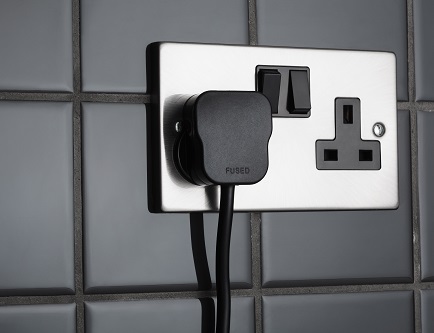 Matching switch and socket finishes are an important, though often overlooked aspect of designed living spaces. Deep consideration needs to be given to aspects of both function (accessibility) and style in order to optimise your investment in your switch and socket.
Matching switch and socket finishes are an important, though often overlooked aspect of designed living spaces. Deep consideration needs to be given to aspects of both function (accessibility) and style in order to optimise your investment in your switch and socket.
Which Switch & Socket Finishes to Match Your Décor and Style?
Matching to other Finishes
A key consideration for matching socket and switch finish, is to think about other finishes they may compliment. If your bathroom has polished chrome taps and towels rails, then polished chrome shaver sockets would be an ideal choice. Similarly, Black Nickel sockets would compliment modern kitchens with black appliances, the same applies for Brushed or Polished Chrome.
Matching to Design Styles
Brass finishes are most often used to compliment period, classical or rustic country styled interiors. These are available in polished, bushed (slight satin effect) or antiqued (darkened to create sense of ageing). Polished finishes should be selected with care as the mirror like finish will show up finger marks, requiring regular polishing.
Brushed Chrome is a common choice for modern and contemporary styles and also works well in vintage and industrial themed settings.
Polished Chrome is adaptable across many different design themes, including modern and contemporary as well as art deco.
Black Nickel is an increasingly popular choice for contemporary styled spaces, providing a striking contrast to bright/white settings and complimenting black entertainment systems or appliances.[related_products is_auto_added="1"]
Switches and sockets are an important, though often overlooked aspect of designed living spaces.
Industrial and vintage lighting is all the rage throughout a host of bars, restaurants, and cafes on every high street. This lighting trend has largely been driven by style and fashion. Vintage LED filament bulbs have exposed glowing filaments that create a warm and personal atmosphere wherever they are used. This makes them perfect for customers that want to relax and socialise.
However, whilst the creation of inviting dining spaces with a modern-retro feel draws in custom, this old-style lighting charm can come at a cost.
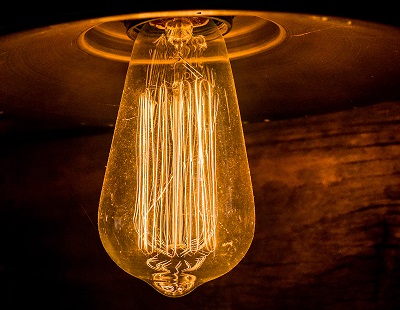
Old Style Charm, but at a Cost
The first generation vintage Edison style filament lightbulbs were based on old power-hungry technology. Typical filament bulbs of that era consumed upwards of 50 watts each. The ultra-thin, intricately threaded filaments were also prone to breakage leading to short life expectancy and expensive replacement costs.
Time Called on Environmentally Unfriendly Filament Bulbs
The EU placed a ban on the manufacture or import of incandescent/filament bulbs in early 2016. So, concerted efforts were made to re-create the old-style charm of the vintage Edison style bulb with ultra-efficient LED technology.
Whilst old incandescent/filament bulbs bought in the UK before the ban can still be sold, LED alternatives are now widespread.
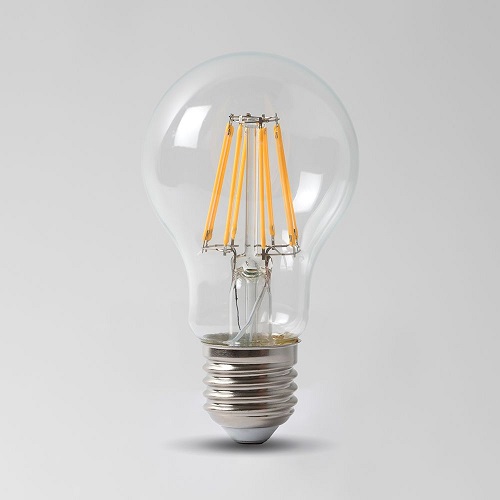
1st Generation LED Filament Bulbs
The 1st generation of filament LED bulbs brought both economy through efficiency (90% less energy consumption) and long-life (5-10 times greater life expectancy) to the market. However, they lacked the appeal, charm, and warmth of the old-style incandescent bulbs.
These bulbs still remain popular, primarily as the prices have tumbled as more have reached the market. They still perform superbly well in light fittings where the bulbs are obscured or not directly on show.
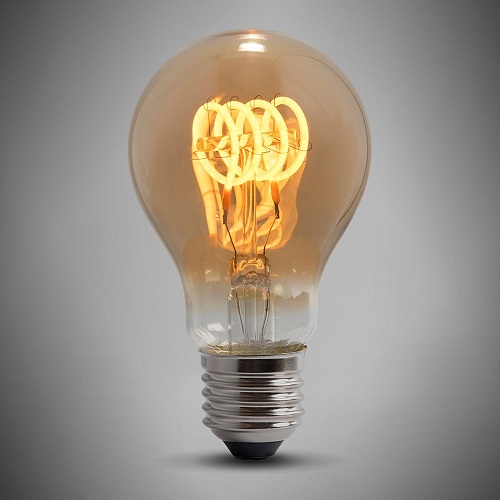
2nd Generation LED Filament Bulbs – Beauty and Efficiency without Compromise
In 2018 the Soho Lighting Company launched its range of 2nd Generation LED Filament Bulbs to the UK market, bringing together old style vintage bulb charm with ultra-efficient LED technology.
These long-life bulbs are suitable for dimmable and non-dimmable applications and use as little as 2-4 watts of energy. When compared to the costs of running and regularly replacing old incandescent lights, these bulbs typically pay for themselves within 9 months and then provide many years of cost-effective service.
Due to the low operating temperatures of these bulbs, they are also ideal for use in air-conditioned spaces, delivering unparalleled efficiency.
Browse our range of LED filament bulbs.
Important Information
Buying Safe Electrical Products for Your Home!
When purchasing electrical and lighting products for your home, always ensure you use a reliable source. Online shopping brings many benefits, but regretfully there are also many untested and uncertified electrical and lighting products now available on popular e-commerce and shopping websites that have been shipped direct from Asia.
Elesi is a member of the LIA (Lighting Industry Association) who advise the EU on lighting standards and testing. We conform to the LIA quality procurement standards and all of our products come fully tested, certified and guaranteed.[related_products is_auto_added="1"]
Industrial and vintage lighting is all the rage throughout a host of bars, restaurants, and cafes on every high street. This lighting trend has largely been driven by style and fashion. Vintage LED filament bulbs have exposed glowing filaments that create a warm and personal atmosphere wherever they are used. This makes them perfect for […]
'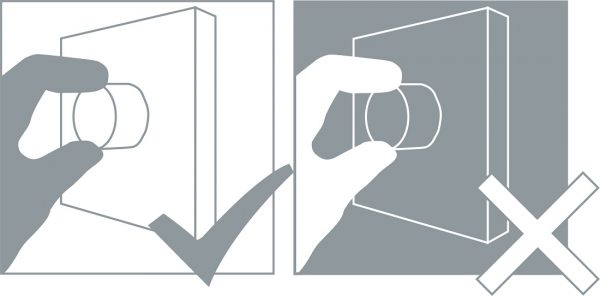 If you're looking to purchase some dimmable LED bulbs, it's worth knowing whether your dimmer will be able to support LED. Using the correct dimmer switch is important for protecting the life of your LED bulbs.
If you're looking to purchase some dimmable LED bulbs, it's worth knowing whether your dimmer will be able to support LED. Using the correct dimmer switch is important for protecting the life of your LED bulbs.
All of our LED bulbs are of the highest quality and fully tested before dispatch. They are suitable in both dimmable and none dimmable applications. However, some customers experience problems because they have dated dimmer switches designed for old, energy hungry incandescent or halogen light bulbs. Some of these analogue dimmers can damage LED's. If you are not sure about your dimmer switch, please follow our guide detailed below..
*PLEASE READ PRIOR TO THE USE OF YOUR NEW LED LIGHT BULB*
To ensure you have compatible switches, if you are using dimmer switches please follow the guidelines below:
- Remove one bulb from the packaging for testing.
- Place switch in the off position to ensure no current is present, then place the bulb in the fitting.
- Turn the light switch on at minimal input position and increase the power gradually.
- If no problems are present, you can now replace the entire set or leave the individual bulb in place.
- Always try and ensure you don’t have a mix and match of bulbs to ensure balanced current distribution. In many cases different brands have different current distribution.
- If you find there is a problem, please don’t worry, but you are likely to need to update your dimmer switch to a modern trailing edge dimmer. This will enable you to use modern efficient LED bulbs which are better for the environment and your pocket.
**ALWAYS ensure you have your electrical wiring/electrical components checked and changed by a qualified electrician where required. We advise that you get your dimmers tested by an electrician prior to installing Led lighting.
If you require a dimmer switch that works with LED bulbs, see our range of screwless dimmer switches.
FAQs
We stock a great variety of different dimmers here at Elesi. Using award-winning Enkin technology, we have smart dimmers, high load dimmers, and even the revolutionary Dimmer Toggle Switch from The Soho Lighting Co.
All of our dimmers can be switched between trailing edge, and leading edge, meaning that you can using each dimmer for LED or Incandescent/Halogen bulbs at the click of a button.
‘If you’re looking to purchase some dimmable LED bulbs, it’s worth knowing whether your dimmer will be able to support LED. Using the correct dimmer switch is important for protecting the life of your LED bulbs. All of our LED bulbs are of the highest quality and fully tested before dispatch. They are suitable in […]
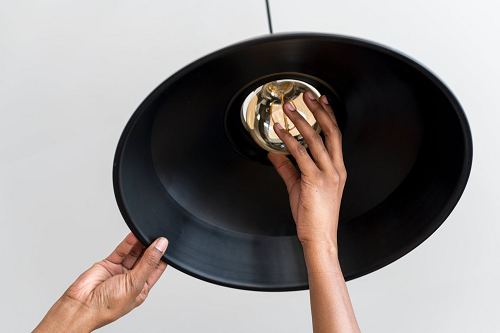 If you are replacing old inefficient or damaged light bulbs, or upgrading to ultra-efficient LED bulbs to deliver cost-saving, environmental and long-life benefits, you’ll need to safely dispose of your old bulbs. In this quick guide, will explain how to dispose of different bulb types responsibly.
If you are replacing old inefficient or damaged light bulbs, or upgrading to ultra-efficient LED bulbs to deliver cost-saving, environmental and long-life benefits, you’ll need to safely dispose of your old bulbs. In this quick guide, will explain how to dispose of different bulb types responsibly.
Standard Incandescent Light Bulbs
These traditional bulbs that we have grown up with can be disposed of in normal household waste. They cannot be recycled as the fine wires are difficult to separate from the glass. We advise that you wrap the bulbs or broken glass in sufficient newspaper or cardboard and secure the package with tape to prevent injury to others handling the waste.
Compact Fluorescent Lamps (CFL Bulbs)
CFL bulbs, also known as energy saving bulbs contain small amounts of mercury and although deemed as safe, they must be collected separately for disposal. There are many local recycling schemes and these are often the best way to dispose of your CFL. To find your local recycling point search for WEEE compliant CFL recycling points.
Halogen Lamps
You can dispose Halogen bulbs in same way as Standard Incandescent Bulbs. Refer to protective packaging advice above for safe disposal.
LED Light Bulbs
LED light bulbs are difficult to recycle and you can dispose these in same way as Standard Incandescent Bulbs. You can refer to protective packaging advice above for safe disposal.
IMPORTANT INFORMATION
Buying Safe Electrical Products for Your Home!
When purchasing electrical and lighting products for your home, always ensure you use a reliable source. Online shopping brings many benefits, but regretfully there are also many untested and uncertified electrical and lighting products now available on popular e-commerce and shopping websites that have been shipped direct from Asia.
Elesi is a member of the LIA (Lighting Industry Association) who advise the EU on lighting standards and testing. We conform to the LIA quality procurement standards and all of our products come fully tested, certified and guaranteed.[related_products is_auto_added="1"]
If you are replacing old inefficient or damaged light bulbs, or upgrading to ultra-efficient LED bulbs to deliver cost-saving, environmental and long-life benefits, you’ll need to safely dispose of your old bulbs. In this quick guide, will explain how to dispose of different bulb types responsibly. Standard Incandescent Light Bulbs These traditional bulbs that we […]
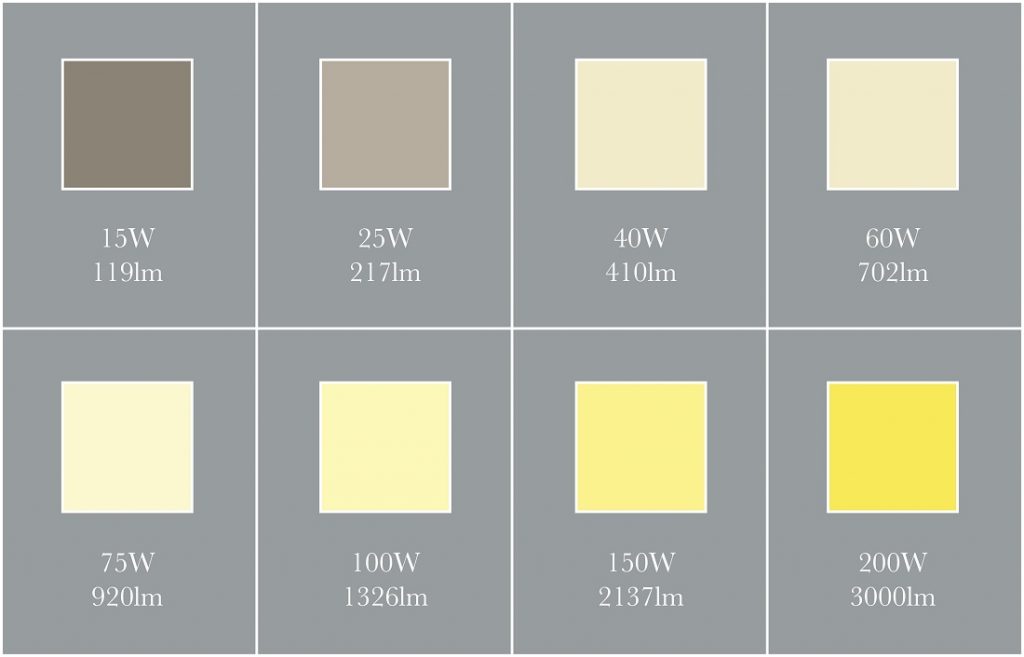
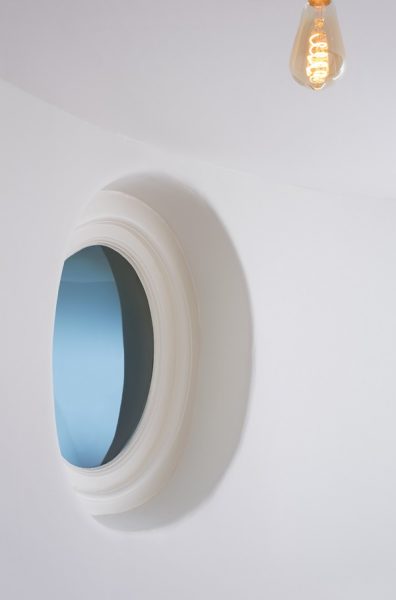 LED Light bulb brightness is often stated in lumens (often shortened to lm). This information is available in the ‘Technical’ tab of all of our light bulb product pages.
LED Light bulb brightness is often stated in lumens (often shortened to lm). This information is available in the ‘Technical’ tab of all of our light bulb product pages.
With traditional inefficient incandescent bulbs of the past, brightness was predominantly gauged in watts. Modern efficient LED light bulbs also give a watt measurement, however because they are so efficient and the energy consumption (measured in watts) is very small, it can be difficult to relate incandescent watts brightness to LED watts brightness. Lumens are a more reliable measure for brightness of an LED bulb and the higher the number of lumens, the brighter the light.
When choosing the best light bulbs for your home, you should consider where the light is situated and how bright the light source needs to be. Bright lighting is important for tasks such as cooking or reading. However it is not ideal for areas of the home where you want to relax or create atmosphere. Dimmer switches are another option to consider as this gives you complete control over the brightness of your light. If you are considering dimming switches, please see our dimmer switch category but be warned, not all dimmer switches are the same!
If you still think in watts rather than lumens, it may be useful for you to see how they compare. Below we have detailed how the wattage of incandescent bulbs compares to the lumens of modern efficient LED bulbs.
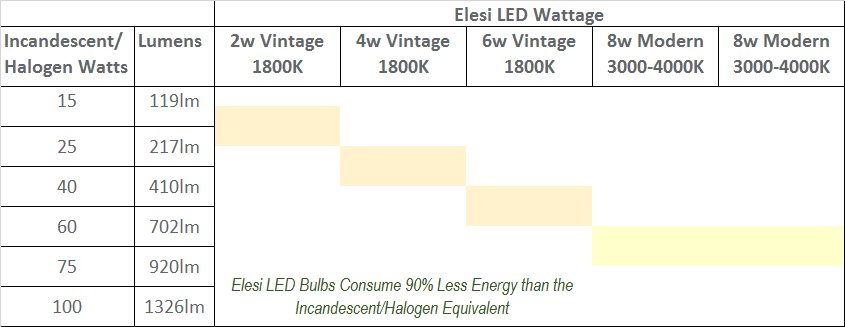
IMPORTANT INFORMATION
Buying Safe Electrical Products for Your Home!
When purchasing electrical and lighting products for your home, always ensure you use a reliable source. Online shopping brings many benefits, but regretfully there are also many untested and uncertified electrical and lighting products. These are available on popular e-commerce and shopping websites that have been shipped direct from Asia. Elesi is a member of the LIA (Lighting Industry Association) who advise the EU on lighting standards and testing. We conform to the LIA quality procurement standards and all of our products come fully tested, certified and guaranteed.
LED Light bulb brightness is often stated in lumens (often shortened to lm). This information is available in the ‘Technical’ tab of all of our light bulb product pages. With traditional inefficient incandescent bulbs of the past, brightness was predominantly gauged in watts. Modern efficient LED light bulbs also give a watt measurement, however because […]
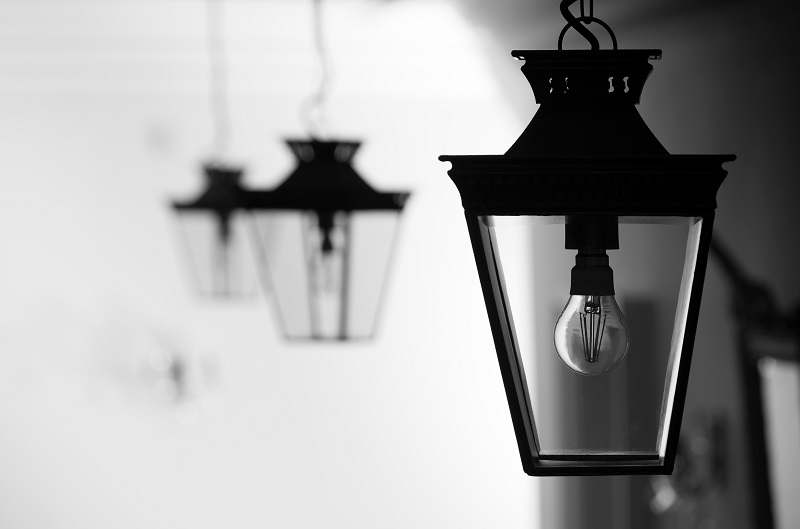
Learn how much money you can save by switching to LED Lights – Save 86% of your lighting costs over 3 years!
Despite the ban on old style Vintage Edison bulbs by the EU in 2016, many remain for sale on the market. However, buying these old-style energy hungry bulbs can be more costly than you might at first think, and not just for the environment.
The table below illustrates the saving that can be achieved for both homeowners and commercial businesses by switching to energy efficient LED lighting.
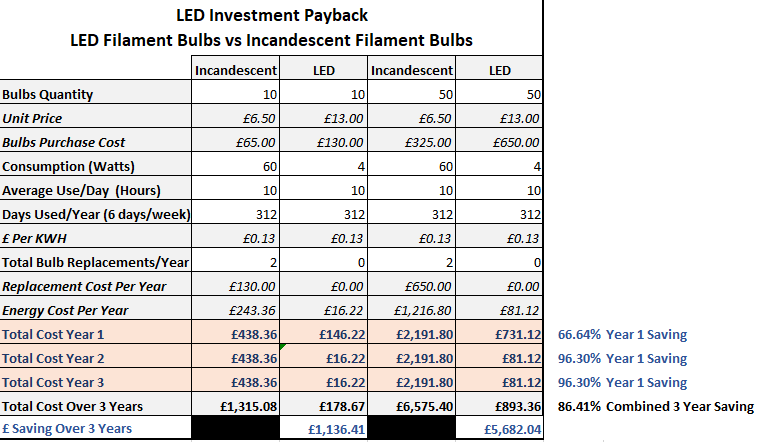
IMPORTANT INFORMATION
Buying Safe Electrical Products for Your Home!
When purchasing electrical and lighting products for your home, always ensure you use a reliable source. Online shopping brings many benefits, but regretfully there are also many untested and uncertified electrical and lighting products now available on popular e-commerce and shopping websites that have been shipped direct from Asia.
Elesi is a member of the LIA (Lighting Industry Association) who advise the EU on lighting standards and testing. We conform to the LIA quality procurement standards and all of our products come fully tested, certified and guaranteed.
Shop LED lighting with us!
We stock a wide variety of LED bulbs that will help you save money on your lighting bills. There are a multitude of ways you can incorporate LED lighting into your home. And the more bulbs you swap for LED's, the more you will save.
LED Downlights
We have a variety of LED downlights, including tiltable, fixed, and even Dim To Warm. Check out our range in a huge variety of finishes.
Bulbs
Our range of bulbs includes all of the popular fittings, and encompass a wide variety of styles. Most of our bulbs are dimmable, and span through smart bulbs, decorative bulbs, and even vintage style filament bulbs!
No, switching to LED lighting couldn't be simpler. LED lighting uses the same fittings as Halogen and Incandescent lighting. All you need to do is match the light fitting to the bulb.
LED lighting has become extremely advanced in recent years. LED lighting now produces beautiful lighting that isn't as harsh as earlier versions of LED's. In fact, LED's produce less of a 'choppy' illusion when moving in LED lighting, thanks in part to more technical advances in the their production.
Learn how much money you can save by switching to LED Lights – Save 86% of your lighting costs over 3 years! Despite the ban on old style Vintage Edison bulbs by the EU in 2016, many remain for sale on the market. However, buying these old-style energy hungry bulbs can be more costly than […]
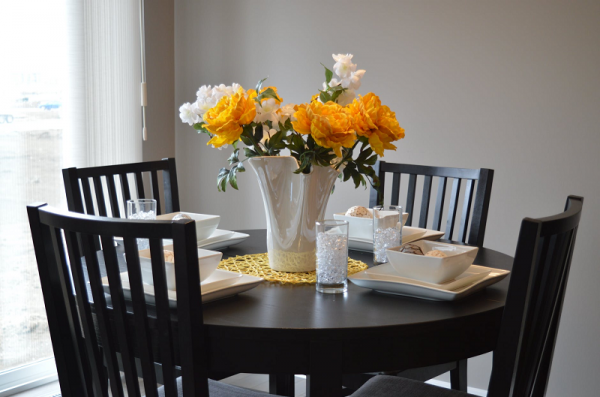 Our customers often ask for lighting advice on their dining room, such as what sort of light bulbs or lighting would suit their dining rooms, what colour temperate is correct, how bright should the lighting be? To answer such questions, it is important to consider the following:
Our customers often ask for lighting advice on their dining room, such as what sort of light bulbs or lighting would suit their dining rooms, what colour temperate is correct, how bright should the lighting be? To answer such questions, it is important to consider the following:
- How will the room be used?
- What look and feel do you want to create in the room?
Kitchens generally need clear, high colour temperature lighting, such as downlights, so you can see what you are doing, and living rooms suit a lower colour temperature for a more relaxing feel, dining rooms sit somewhere in the middle, as it's good to see the colour of the food, but too bright, and the light can take away the atmosphere.
Dining rooms are a gathering place for eating and socialising, so the lighting needs to be warm and comforting and create an ambience.
When planning the layout of your dining room and the different styles of lighting, you may want to choose these three options:
Task lighting
For task lighting, you'll need a higher colour temperature (for example 4100k). This will provide a bright light to make it easier to see what you are doing. If, however you don't use your dining room for completing tasks, you may not need task lighting.
Accent lighting
This is lighting that focuses on a particular area or object. If you have art on your walls or interesting architectural detail, you may want to use accent lighting, but it is, of course not for every dining room.
Ambient lighting
This is the main, most important way of lighting you'll need in your dining room. This sets the tone and ambience of the room. It should provide enough light for people to see what they are doing and eating, but not so much that it feels too bright. Whilst a 4100K bulb may be too bright, you could try something towards 3000K, or if you want to set a truly vintage style, then a 1800k decorative bulb could be a good idea.
You can also consider using a 3000k bulb in your main ceiling lighting fixture, and a 1800K decorative bulb in a floor lamp, to give you a mixture of light sources and choices. Generally it is best to have light from multiple sources to avoid creating glare and shadows. Dimmer switches can also be a great addition to any dining room as you can choose the brightness to suit or set the mood.
If your dining room is your space for entertaining guests, consider using decorative bulbs and light fixtures to create a centrepiece.
There are a couple of different rules that you can follow to make sure you have a good pendant light size for your dining room. If you’ve already chosen your table, then it’s a good idea to choose a light that is one half to three quarters the width of the table.
If you haven’t chosen a table yet, you can add the length and width of your room in feet, and switch to inches for the light. So if you have an 8’ x 10’ room, then an 18” pendant would suit.
Our customers often ask for lighting advice on their dining room, such as what sort of light bulbs or lighting would suit their dining rooms, what colour temperate is correct, how bright should the lighting be? To answer such questions, it is important to consider the following: How will the room be used? What look […]
Lightbulb fittings, also known as caps or bases, come in various shapes and sizes. The first step in any bulb purchase is to therefore identify the fitting type you need.
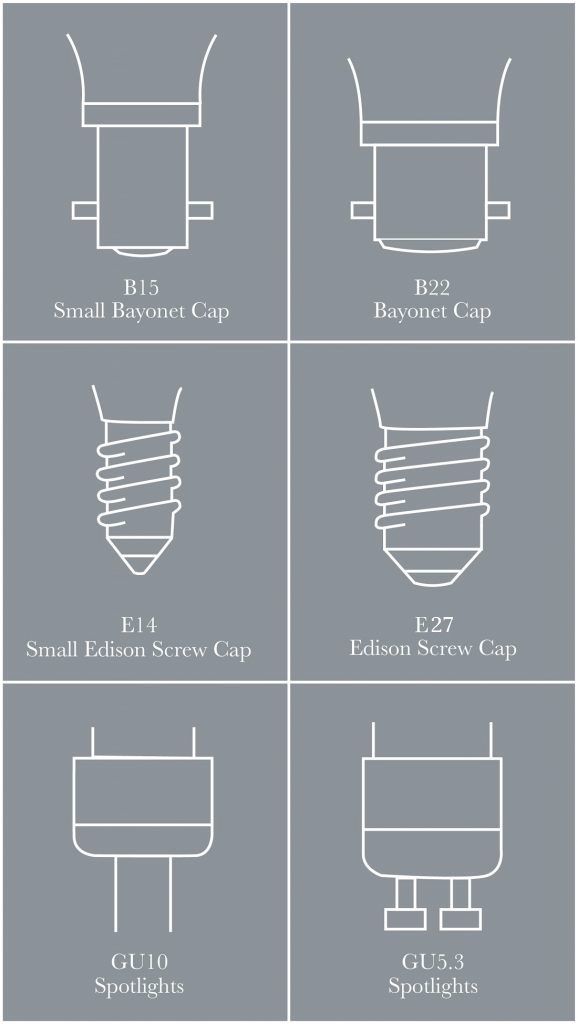
Bayonet Bulb Fittings B22 and B15
First, let's look at Bayonet bulbs.
The larger B22 (22mm) diameter fitting was the most common cap fitment in the U.K. for many years.
The smaller B15 (15mm), also known as the small bayonet cap, or the SBC, looks like a miniature version of the B22. The B15 is often a popular choice for delicate/elegant light fittings which suit more slender bulbs
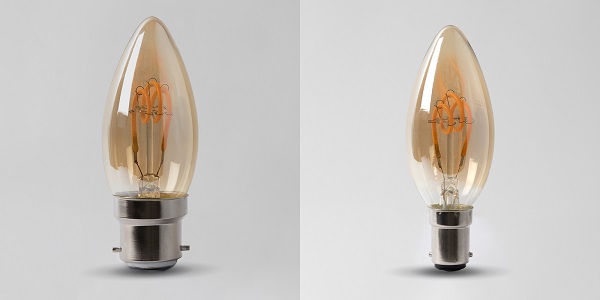
B22 Cap (Left) & B15 Cap (Right)
Bayonet caps have two locating pins, requiring the familiar push and twist action to fit the bulb into the holder.
Edison Screw Cap Bulb Fitting
Now we will look at screw in caps, named after Thomas Edison, are also known as ES lamp fittings and is used worldwide on a large number of bulbs. The most common Edison Screw caps are the E27 and the E14.
The E27 fitting is the larger of the two most common ES caps with its diameter at 27mm and height at 26mm. This has a standard 27mm screw which fixes the bulb into the fitting.
The E14, also known as the Small Edison Screw or SES is often used for smaller lightbulbs and has a diameter of 14mm. It is mainly used in the UK and the rest of Europe.
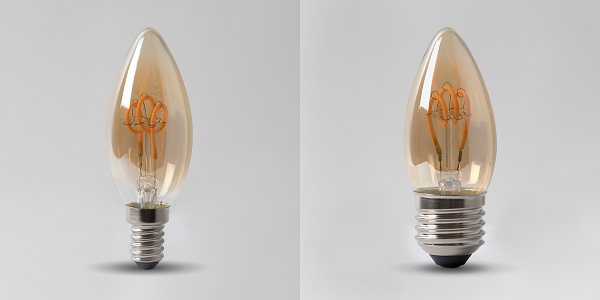
E14 Cap (Left) & E27 Cap (Right)
Halogen and LED Spotlights
Finally, these are most common halogen spotlights either come with push fit fittings or twist and lock fittings. You can identify the fitting by measuring the distance in mm between the centre of the two pins on the base of the bulb.
The GU10 is a twist and lock fitting with a 10mm distance from pin centre to pin centre. This is the most popular type in the UK and the light is mains operated 240V.[related_products is_auto_added="1"]
Lightbulb fittings, also known as caps or bases, come in various shapes and sizes. The first step in any bulb purchase is to therefore identify the fitting type you need. Bayonet Bulb Fittings B22 and B15 First, let’s look at Bayonet bulbs. The larger B22 (22mm) diameter fitting was the most common cap fitment in […]
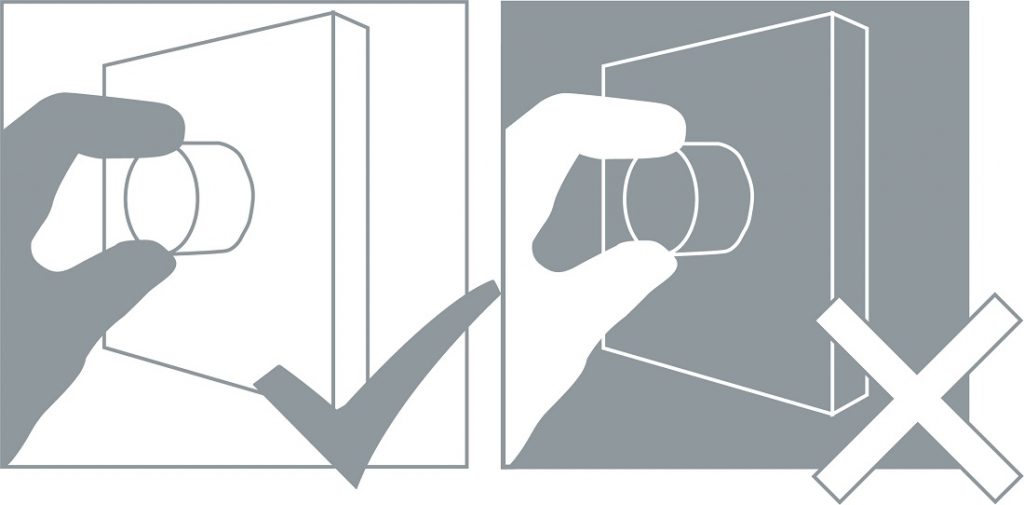
If you're trying to decide what light bulbs to purchase for your home, you may be asking "do I need dimmable LED light bulbs?". You'll no doubt have seen a number of dimmable and non-dimmable options on the market. But, are they better?
Dimmable LED light bulbs are great for creating a bit of an atmosphere when entertaining guests, watching a movie or eating dinner. Before choosing to buy dimmable though, it's worth knowing a little bit more about their uses and their benefits.
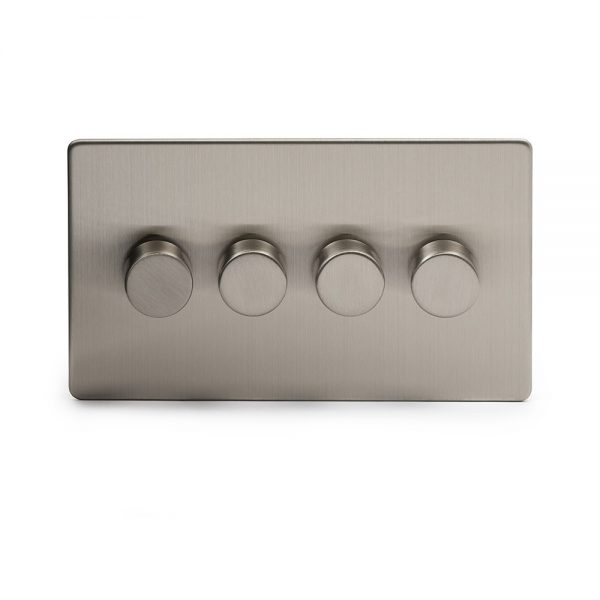 How Dimmable LED Light Bulbs Work
How Dimmable LED Light Bulbs Work
Firstly, let's look at how LED lights work. There are two main methods of LED dimming, the analogue method and Pulse Width Modulation (PWM). PWM dimming doesn't rely on a change in voltage to dictate the brightness level. Instead it uses a cycle of being on and off. These cycles are so fast that you won't be aware of them. Analogue dimming involves the current being controlled to either dim or brighten the light.
Flickering LEDs
You may have heard people complaining that their LED bulbs flicker when dimmed. This is usually something that can be tracked back to the dimmer switch. Many older dimmer switches are mainly designed for older bulbs on a higher wattage. These aren't so good at coping with LED bulbs. When choosing a dimmer switch, make sure it is one that is compatible with LED lights.
The Price
Dimmable LEDs can be more expensive than non-dimmable LEDs. This is because dimmable LEDs have additional technology that increases the cost of manufacture. LEDs are also more expensive than halogen bulbs as they save money on energy bills and last much longer. We should note, however that our LED bulbs are suitable for both dimmable and non-dimmable applications and are still competitively priced with non-dimmable LEDs.
If you already have a dimmer switch in place, and are switching to LED, make sure you choose dimmable LED bulbs, and make sure they are compatible with that sort of dimmer. If you use a dimmer that is not compatible with LED’s then you can run the risk of damaging the driver that controls the LED. You'll also need to make sure you buy high quality LED bulbs. Not just for safety reasons (a lot of bulbs available online have been imported without proper regulation. These are potentially unsafe as they may be uncertified) but also for function reasons.
All LED lights have a driver (Halogens use transformers) that provides a constant current to light up LEDs (LEDs are current driven). The driver takes the 240/120v AC input and converts it into a DC current. It is the LED driver that must receive the TRIAC dimmed AC wave form and convert it in to a PWM signal for the LED to dim properly. In actual fact for every 100 ON/OFF cycles of the TRIAC signal the PWM signal will probably flip/flop many thousands of times. This is necessary to avoid any perceivable flicker.
Some final key points:
- Many LED drivers on the market claim to be able to dim but either flicker too much at low levels, or do not dim to more than 30%
- If you are replacing older halogen downlights, you will likely need to replace the dimmer with a Trailing or Universal.
- Don't mix LED down lights from different manufacturers (different drivers) on the same dimming circuit (may introduce flickering)
Almost all of the light bulbs that we stock are dimmable LED bulbs. Please ensure you have selected a dimmable LED bulb before checkout.
Yes. Dimmable bulbs will work with non-dimming switches.
We stock a wide range of award-winning Enkin Dimmers. These are all designed to be buzz free, and flicker free too! These are available in pre-made switches in a wide variety of finishes, or as buildable modules.
Yes! We stock Smart Dimmers, as well as the revolutionary new Dimming Toggle from Soho Lighting. This beautiful new switch allows you to dim your lights with a press of a switch, and offers stylish dimming in a wide range of finishes.
If you’re trying to decide what light bulbs to purchase for your home, you may be asking “do I need dimmable LED light bulbs?”. You’ll no doubt have seen a number of dimmable and non-dimmable options on the market. But, are they better? Dimmable LED light bulbs are great for creating a bit of an […]
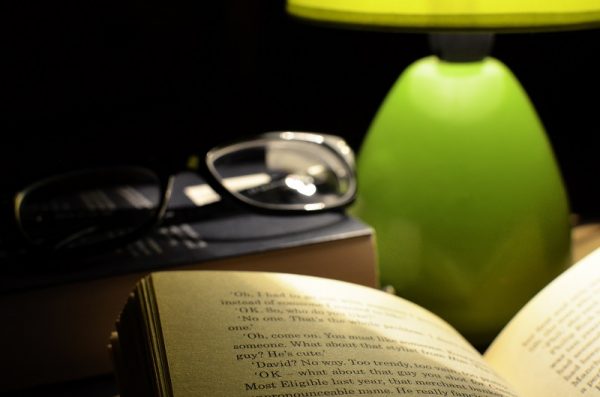 Reading at night can be a relaxing way to end the day and quieten your mind, helping you to get a good night's sleep. When we were young, we were all warned that reading in poor light would ruin our eyesight, however doctors have agreed that there is no evidence that poor reading light can damage vision over time. It can, however cause negative short-term effects including eye strain and headaches. Choosing the right lighting can make reading in bed much more comfortable, and also help you to relax.
Reading at night can be a relaxing way to end the day and quieten your mind, helping you to get a good night's sleep. When we were young, we were all warned that reading in poor light would ruin our eyesight, however doctors have agreed that there is no evidence that poor reading light can damage vision over time. It can, however cause negative short-term effects including eye strain and headaches. Choosing the right lighting can make reading in bed much more comfortable, and also help you to relax.
One important thing to think about when choosing the lighting for reading is getting evenly distributed levels of light. A common mistake is to have one extremely bright bedside lamp, fully focused in one place with pitch black everywhere else. This can cause your pupils to dilate from the dark when looking around and can make your eyes become fatigued.
As you get older, you may need to use a brighter light for reading at night. This is simply because our eyesight gets worse with age. Therefore you need to increase the wattage as you get older. A 10 year old may be able to read with a 40 watt standard bulb (equivalent of a 6W LED bulb), but a 60 year old may need a 75 or 100 watt standard bulb (equivalent of 13W-18W in LED terms). Keep in mind though that too much light or glare can be bad too. If reading at night with a bright light is giving you a headache or making your eyes tired, use a shade or switch to a less bright light.
For an idea of how the wattage of incandescent standard bulbs relates to modern LED lighting, see the table below:
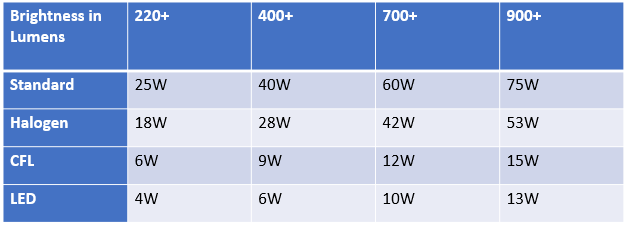
Light Bulb Colour Temperature
Colour temperature is also very important when considering which bulb to choose for bedtime reading. The important thing is to remember that you need to see the words clearly. However you don't want to be over-stimulated by bright cool light.
A nice warm white or sunset white can provide a relaxing tone. Anything above 3000K may be a bit too much for bedtime reading. Bulbs that have a higher colour temperature look closer to daylight. Bulbs with a lower colour temperature tend to have the colour of a candle.
Using a smartphone or tablet in bed at night can have a negative impact on your sleep. This is because ocular light exposure disrupts your body’s natural ability to produce melatonin. Melatonin is the hormone produced by the pineal gland that helps you to fall asleep. Using a smartphone that produces ocular light at night can therefore throw your body clock out of rhythm.
Basically, when you look at a smartphone or tablet at night time, you’re tricking your body into thinking you are looking at sunlight and should therefore be awake. It is the bright, blue light emitted by the devices that really causes the issue. Many newer smartphones have features that detect when it is close to bedtime. They then change the brightness and colour temperature, so you don’t disrupt your body clock.
If you choose a light bulb that has a high colour temperature, for example, a bluey, white daylight bulb, you could easily trick your body into thinking it is daytime and, whilst you may be able to clearly see the book, you could ruin your sleep. A more orangey, warm bulb will help to eliminate this problem.
Your choice may come down to personal preference though. So if your current bulb is giving you a headache, consider changing to a different colour temperature or a less powerful bulb.
Yes! We stock a wide variety of bulbs in different fittings, with a variety of different colour temperatures.
We don't just stock different colour temperature bulbs, we also do dim to warm downlights. These innovative light bulbs allow you to change the colour temperature of your lights from a functional cool light, to a more comfortable warm reading light through the use of a dimmer.
Choosing the right lighting can make reading in bed much more comfortable, and also help you to relax. We look at some of the best light bulbs for reading at night.